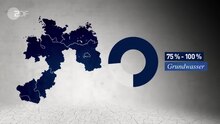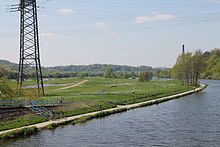Water extraction
In water extraction , water is obtained from different sources in different ways.
Rainwater
Precipitation water (such as rain, snow, fog or hail) is available almost everywhere, depending on the local amount of precipitation , but the supply on this basis is very uncertain because of the irregular and unpredictable distribution. In addition, rainwater, depending on its nature, can be used for human consumption. U. is not immediately suitable (electrolyte-free).
Surface water
River water
River water is most exposed to pollution and therefore the least suitable for drinking water supplies . River water should only be used when no other water is available.
River water is mainly due to its strong quality fluctuations for the operating water supply used. The water quality is often inadequate for economic use for water supply , or only after complex treatment. In order to obtain water with a low suspended matter content and better quality, as well as to achieve a better temperature profile and to design the treatment of the water more simply, attempts are made, as far as the geological formations allow, to tap bank filtrate .
Lake water
For seawater extraction , deep are mostly nutrient-poor lakes with sufficient supply. In contrast to shallow lakes, lakes from around 40 m depth create a temperature equalization similar to that of the groundwater . The water quality essentially depends on the supply of contamination from the tributaries of the catchment area and the bank areas , as well as the use of the lake (e.g. leisure and recreation ). Generally, only the mean annual inflow can be obtained, minus the losses, while the volume of the lake has a compensatory effect.
Dam water
Reservoir basins are created by artificially blocking valleys . They can hold large reserves of drinking and service water and at the same time serve as retention basins to regulate the flow fluctuations of rivers and as water storage for hydropower plants (multi-purpose dams). The water level in the reservoir of a dam usually fluctuates considerably depending on the extraction of the water for the intended use. The changing water level in the dams distinguishes these artificial lakes significantly from the natural lakes, which generally have low water level fluctuations. As with natural lakes, the water quality is essentially determined by the quality of the tributaries from the catchment area.
Sea water
The majority of all precipitation is caused by evaporation over the oceans , which is therefore of decisive importance for water management . Efforts to desalinate seawater began in ancient times . However, in the last 40 years the question of the production of drinking and industrial water has become more and more urgent for many countries, especially in the arid and semi-arid regions of the world. Well-engineered designs for desalination plants are available, with the development of even more efficient plants. It is not yet clear whether a z. Process that is currently still uneconomical can later become quite attractive due to its further development.
Seepage water
Leachate is original rainwater that initially moves vertically underground. If it hits a water-impermeable layer, stratified water is created that either remains in place or moves horizontally on a slope. Strictly speaking, seepage water and stratum water are also groundwater, since if they stay in the ground for a long time, it becomes groundwater. Groundwater is also renewed / replenished by seeping precipitation.
Groundwater

Due to its often very stable quality, groundwater is preferably used to obtain drinking water.
Approx. 25% of the world's population get their drinking water from karst - aquifers . The Institute for Applied Geosciences at the Karlsruhe Institute of Technology (KIT) published as a project of the IAH Karst Commission ( International Association of Hydrogeologists ) in September 2017 at the 44th annual congress of the IAH in Dubrovnik in addition to the groundwater world map published in 2000 ( World- wide Hydrogeological Mapping and Assessment Program, WHYMAP) together with the Federal Institute for Geosciences and Natural Resources (BGR) and UNESCO a " World Karst Aquifer Map ".
humidity
Humidity is used to obtain water in areas where morning fog usually dissipates due to air movement and solar radiation. This is possible in certain regions such as Friesland in dew ponds . Elsewhere, condensation water is generated and collected on installed networks. Such a plant in Chungungo ( Chile ) produces around 12,000 liters of drinking water per day. There is scientific research that uses the technology of the fog drinker beetle for water extraction.
See also air wells
Methods for obtaining water
Surface water
Surface water is usually obtained by pumping or pumping stations . In the case of dams, there are often special outlets in the barrier structure that allow extraction from deeper water layers.
Groundwater
Groundwater is mainly obtained from wells or natural sources are used.
Seepage water
Since seepage water often gathers over the actual groundwater in the mountains due to impermeable layers (reservoirs of seepage water are called stratified water), tunnels and shafts were built early on in the plateaus of ancient Iran to collect seeping rainwater. This technique is called qanat .
Rainwater
Artificial or natural pools are used to collect rainwater, e.g. B. cisterns , rain barrels or the like. For unorthodox water extraction processes, more specialized methods such as B. networks used.
Water treatment
The raw water obtained from the various sources is often further processed in water treatment plants , depending on requirements, with varying degrees of effort .
See also
Web links
Individual evidence
- ↑ Merk, Markus (AGW): KIT - AGW: WOKAM. September 10, 2017, accessed December 8, 2017 (German).
- ^ Nico Goldscheider, Neven Kresic: Karst hydrogeology home. Retrieved December 8, 2017 .
- ↑ BGR - WHYMAP. Retrieved December 8, 2017 .
- ↑ BGR - WHYMAP - BGR, KIT, IAH, and UNESCO presented new World Karst Aquifer Map. Retrieved December 8, 2017 .
-
^ Chile: water from the air. In: Quarks & Co, consignment in short supply: water . WDR television, accessed on July 19, 2008 . Fog water harvest in Peru with German know-how
- ↑ Nanotechnology: Magic Bottle ( Memento from January 3, 2013 in the Internet Archive ), NewScientist 49/2012 from November 30, 2012
- ↑ Exemplary: Desert beetles catch moist air , Spiegel Online from November 1, 2001

